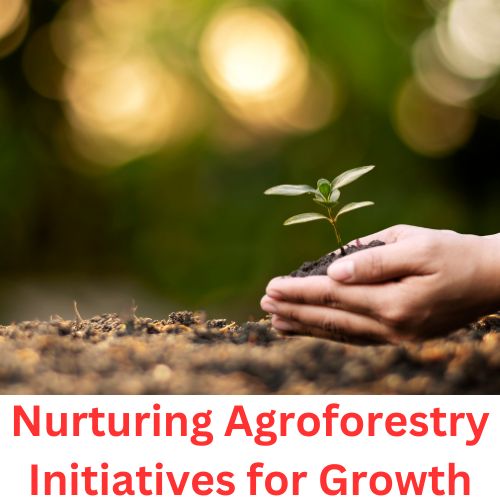Introduction
Agroforestry, the practice of integrating trees and shrubs into agricultural systems, has gained recognition for its potential to promote sustainable land use, mitigate climate change, and enhance food security. As the world faces pressing environmental and agricultural challenges, nurturing agroforestry initiatives becomes essential for ensuring a greener and more prosperous future. In this narrative, we delve into the multifaceted world of agroforestry, exploring its significance, principles, success stories, challenges, and the critical steps required to nurture and expand agroforestry initiatives for sustainable growth.
Chapter 1: The Roots of Agroforestry
To understand the success of agroforestry initiatives, it’s crucial to explore the historical context and the origins of this practice.
1.1 Historical Origins
Early human practices: Ancient civilizations, such as the Mesopotamians and Mayans, embraced the integration of trees and crops, recognizing the benefits of agroforestry.
Indigenous wisdom: Indigenous communities worldwide have practiced agroforestry for generations, preserving their ecosystems while sustaining their livelihoods.
1.2 Modern Evolution
Formalization of agroforestry: The term “agroforestry” gained prominence in the 1930s, marking the beginning of scientific research and development in the field.
Key influencers: Pioneers like Robert Hart, J. Russell Smith, and Fikret Berkes shaped modern agroforestry principles and practices.
Chapter 2: Principles and Benefits of Agroforestry
To nurture agroforestry initiatives successfully, it’s essential to understand the core principles and the multitude of benefits this practice offers.
2.1 Biodiversity Enhancement
Diverse ecosystems: Agroforestry promotes biodiversity by creating complex, multi-layered landscapes that provide habitats for various species.
Resilience to pests: A diverse range of plant species makes it harder for pests and diseases to devastate crops.
2.2 Soil Health and Erosion Control
Improved soil fertility: Nitrogen-fixing trees and nutrient accumulator species enhance soil nutrient levels, reducing the need for chemical fertilizers.
Soil erosion prevention: Tree canopies and root systems stabilize soil, preventing erosion and land degradation.
2.3 Climate Change Mitigation
Carbon sequestration: Trees in agroforestry systems absorb and store carbon dioxide, mitigating the effects of climate change.
Microclimate regulation: Trees provide shade and windbreaks, creating microclimates that benefit crops and livestock.
Chapter 3: Success Stories in Agroforestry Initiatives
The success of agroforestry initiatives can be witnessed in various regions worldwide, where practitioners have harnessed its potential for sustainable development.
3.1 Taungya System in Southeast Asia
Originating in Myanmar, the tangy system involves temporary tree planting among crops, promoting reforestation and enhancing land productivity.
Case study: The Philippines’ successful reforestation efforts through the tangy system.
3.2 Silvopasture in North America
Silvopasture combines trees, livestock, and forage in a mutually beneficial system, providing shade, improved forage quality, and enhanced animal welfare.
Case study: A rancher in the United States adopting silvopasture practices to boost cattle production while conserving natural habitats.
3.3 Alley Cropping in Africa
Alley cropping involves:
- Planting rows of trees amidst annual crops.
- Enhancing soil fertility.
- Providing additional income through tree products.
Case study: A smallholder farmer in Ghana using alley cropping to improve food security and income.
3.4 Homegardens in Southeast Asia
Home gardens are:
- Small-scale agroforestry systems around homes.
- Providing families with diverse food sources.
- Medicinal plants.
- Timber.
Case study: An Indonesian family practicing homegardening for nutritional needs and extra income.
Chapter 4: Challenges and Opportunities
While agroforestry initiatives offer immense potential, they also face challenges and opportunities that must be addressed for sustainable growth.
4.1 Land Tenure and Rights
Ambiguity in land tenure can discourage farmers from investing in agroforestry, as they fear losing their trees in case of land disputes.
4.2 Knowledge and Extension Services
Access to agroforestry knowledge and extension services in rural areas can help adoption. Initiatives to disseminate information are essential.
4.3 Policy Support
Government policies and international organizations can promote agroforestry through incentives, subsidies, and supportive regulations.
4.4 Market Access
Agroforestry products often need help accessing markets; value addition and market linkages can address this issue.
Chapter 5: Nurturing Agroforestry Initiatives for Growth
Specific steps and strategies must be employed to ensure the continued success and expansion of agroforestry initiatives.
5.1 Education and Training
Promote education and training programs to build capacity among farmers, extension workers, and policymakers in agroforestry practices.
5.2 Research and Innovation
Invest in research and innovation to develop new agroforestry techniques, tree species, and marketable products.
5.3 Policy Advocacy
Advocate for supportive policies at the local, national, and international levels to incentivize agroforestry adoption.
5.4 Financial Support
Encourage financial institutions to provide loans and credit to farmers interested in agroforestry, reducing financial barriers to entry.
5.5 Networking and Collaboration
Foster collaboration among stakeholders, including government agencies, NGOs, and farmers’ organizations, to create a supportive ecosystem for agroforestry.
Conclusion
“Saplings of Success: Nurturing Agroforestry Initiatives for Growth” has delved into agroforestry, highlighting its historical roots, principles, benefits, and successful case studies from around the globe. Agroforestry, with its potential to enhance biodiversity, improve soil health, mitigate climate change, and boost food security, is a sustainable solution to numerous environmental and agricultural challenges.
Despite its challenges, such as land tenure issues and limited knowledge dissemination, agroforestry has a bright future. We can nurture agroforestry initiatives by fostering education, research, policy support, financial assistance, and collaboration and ensure their sustainable growth. As the saplings of agroforestry initiatives continue to take root and flourish, they promise a greener and more prosperous world for generations to come.
